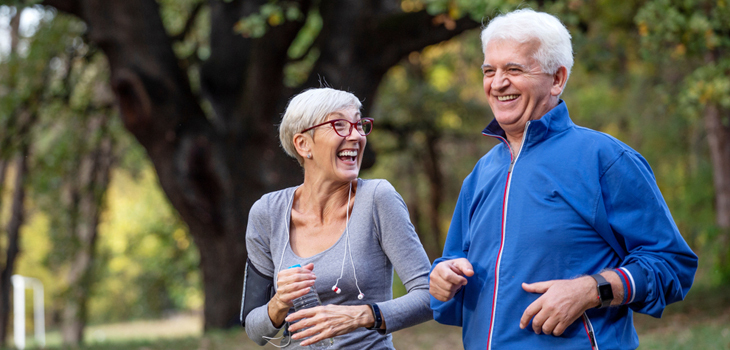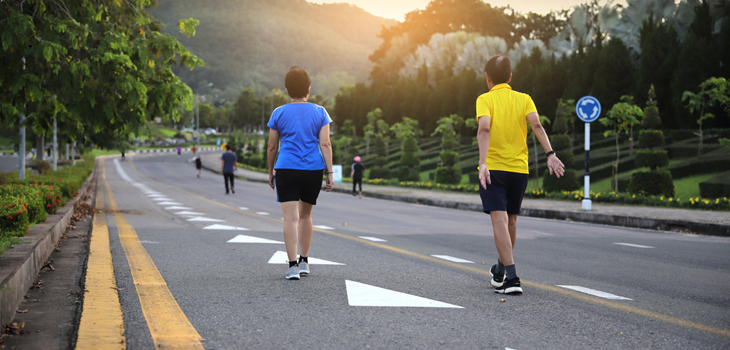Walking has many health benefits for people of different ages and fitness levels. It may also aid in the prevention of certain diseases and even the extension of life. Walking is the best form of exercise for health because it is gentle on the heart and joints and thus has a greater effect on overall health. Intense exercise has larger and faster effects on the body, but it can also harm the joints and bones. Walking, on the other hand, is free and easy to incorporate into one’s daily routine. All that is required to begin walking is a good pair of walking shoes. It’s easy enough for almost any able-bodied person to do. It has numerous advantages, including increasing the body’s metabolism and strengthening the various joints, muscles, and bones throughout the body—not to mention it’s an excellent way to relieve stress and enjoy some alone time.
Most experts recommend walking for at least 30 minutes per day. It is entirely up to you whether you decide to lace up your walking shoes and walk to work, walk with a friend, or join a hiking club; studies show that walking lowers blood pressure, reduces the risk of chronic diseases, and lets your heart and brain more sharply function. As you carry your body weight when walking, it is a weight-bearing workout. It is one of the most basic forms of physical exercise, and as little as a daily brisk walk can help you live a healthier life. Walking has the most benefits when you walk faster, farther, and more frequently. Continue reading to find out more about the advantages of walking:
Walking Lowers Blood Pressure
A study conducted to determine the effect of walking on blood pressure discovered that 40 minutes of daily walking reduced blood pressure levels in people with hypertension. Patients who walked these 40 minutes all at once had a 5-point drop in blood pressure, while those who took four separate 10-minute walks had a 3-point drop. The doctors who conducted the study concluded that it is critical for everyone to make the choices that are best for them in order to achieve the desired results. Nonetheless, experts agree that walking for at least 30 minutes five days a week can significantly reduce the risk of coronary heart disease. When you increase the duration or distance you walk per day, your risk level may decrease even further.
Walking Can Help Lower Blood Sugar Levels
Walking is an essential activity that the American Diabetes Association recommends to individuals in order to lower blood sugar levels and reduce the overall risk of diabetes. A study on this topic was even conducted, and it suggested that walking 3,000-7,500 steps per day could be effective in treating or preventing type 2 diabetes. This study also suggests that people should take short breaks between long periods of sitting and go for short walks or do a few exercises that are appropriate for their body. In other words, walking lowers blood sugar levels, which are responsible for type 2 diabetes.
After eating, a short walk can also help lower blood sugar levels. A 15-minute walk after each meal, three times a day, has been shown to improve blood sugar levels more than a 45-minute walk at a different time of day. If you make a post-meal walk a regular part of your routine, it can help you stay fit throughout the day.
Walking Assists in Maintaining Weight & Burn Calories
Regular walking, according to research, can help reduce belly fat and, as a result, improve insulin sensitivity. It burns calories, and burning calories can help in maintaining or losing weight effectively. The actual number of calories burned is determined by several factors, including walking speed, distance covered, terrain (more calories are burned when walking on an elevation than when walking on a flat surface), and body weight. A calorie calculator can help you determine your actual calorie burnt if you wish to quantify your performance for analysis. Walking every day increases metabolism through burning excess calories and preventing loss of muscle mass, which is extremely crucial for the elderly.

Walking Can Help You Get Rid of Joint Pain
Walking can protect joints like the knees and hips by lubricating and strengthening the muscles that support them. Walking on a regular basis improves the body’s range of motion and mobility by increasing blood flow to tense areas and strengthening the muscles that surround the joints. Taking a 15–30 minute walk outside each day is an effective way for the body to absorb Vitamin D, a deficiency of which can lead to weakened bones, fractures, and difficulty walking.
Walking for at least 10 minutes per day, or one hour per week can help older people avoid disability and arthritis pain. It is a safe, low-cost, and convenient form of exercise for arthritis patients of all fitness levels.
Walking Can Magnify Brain Function & Increase Creativity
A study evaluated brain scans of people walking briskly for one hour three times per week to people that attended education seminars and discovered that those who walked had more efficient decision-making regions of their brains than the other group. The experts concluded that these advantages could be attributed in part to increased blood flow to the brain during exercise.
A similar study conducted by Stanford University researchers concluded that walking can also help clear the mind and think creatively. They discovered that a person’s creativity increases while walking and for a short time after they finish. Walking both indoors and outdoors boosted creativity, so the environment didn’t play a role. Many participants indicated that they get all of their best ideas while walking. The researchers concluded that walking allows for a free flow of ideas and is a simple way to boost creativity while also getting some exercise.
Walking Helps in Improve Mood & Boost Energy
A 10-minute walk can lift spirits in the same way that a glass of wine or a square of dark chocolate does, but without the extra calories. This effect is amplified when taking a walk in the woods. Walking on a regular basis is said to alter the nervous system to the point where an individual’s usual level of anger and hostility decreases. This is especially useful during the colder months when depression is more common.
Walking helps to improve mental health by reducing depression, anxiety, and other negative emotions. It boosts self-esteem and alleviates social withdrawal symptoms. A walk with your partner, friend, or a neighbor can make you feel socially connected, strengthen your bonds and make you feel happier. To reap these advantages, aim for 30 minutes of brisk walking or other moderate-intensity exercises three times per week. You could also divide it into three 10-minute walks.
Walking Stimulates Immune System & Improves Sleep
A daily 30-45-minute moderate-pace walk is the most effective way to protect your body from common colds. A study of 1,000 adults was conducted during the flu season. Following moderate-intensity walking for 30 to 45 minutes each day, the immunity booster levels remained high for several hours after the exercise. In general, those who participated in this exercise had 43 percent fewer sick days and upper respiratory tract infections. In comparison to sedentary adults in the study, their symptoms were also less severe. This study demonstrated that walking improved health and the immune system over time.
Walking also has the added benefit of allowing you to sleep better at night. A good night’s sleep is essential for maintaining a healthy immune system, digestive system, and mental health. Individuals who walk daily have a significant positive impact on sleep quality and length of sleep because walking helps reduce pain and stress, both of which are common causes of sleep disturbances.

Walking Slows Ageing & Extends Life Span
Walking is one of the most effective ways to avoid mobility loss that is commonly associated with aging. Walking and tai-chi are two examples of moderate-intensity exercises that not only tighten but also reverse the aging process. These exercises are the most effective in preventing dementia, a type of disease that affects the majority of people as they get older. Above all, it is said that faster walking can help you live a longer life. According to one study, walking at an average pace rather than a slow pace resulted in a 20% lower risk of death overall. When walking at a brisk or fast pace, this risk is reduced by 24%. The study looked at the link between faster walking and factors like overall causes of death, cardiovascular disease, and cancer death. Walking provides the cardiovascular workout that is most likely responsible for this benefit.
Conclusion
Everyone, regardless of their age or fitness level, can benefit from daily walking. It is a healthy and enjoyable creative outlet that can benefit both your health and your mind in unexpected ways. The human body is not designed to be lethargic all day, and any type of movement is preferable to none. Finding a sort of action that is appropriate for your age and fitness level will help you to feel empowered and motivated. Walking is a great way to exercise the muscles and keep your heart healthy. Consider getting a pedometer or another type of fitness tracker to help you keep track of your daily steps.

